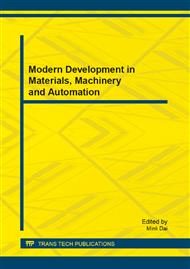[1]
F. Yang, M.H. Tang, Z. Ye, Y.C. Zhou et al., J. Appl. Phys. Vol. 102 (2007), p.044504.
Google Scholar
[2]
F. Yang, G.D. Hu, B. X. Xu, W.B. Wu et al., J. Appl. Phys. Vol. 112 (2012), p.034113.
Google Scholar
[3]
F. Yang, Y.C. Zhou, M.H. Tang, F. Liu, J. Appl. Phys. Vol. 106 (2009), p.014110.
Google Scholar
[4]
F. Yang, Y.C. Zhou, M.H. Tang, F. Liu, Y. Ma et al., J. Phys. D: Appl. Phys. Vol. 42 (2009), p.7.
Google Scholar
[5]
V. Garcia, S. Fusil, K. Bouzehouane, S. Enouz-Vedrenne et al., Nature, Vol. 460 (2009), pp.81-84.
DOI: 10.1038/nature08128
Google Scholar
[6]
V. Garcia, S. Fusil, K. Bouzehouane et al., Science Vol. 327 (2010), pp.1106-1110.
Google Scholar
[7]
S.L. Miller, R.D. Nasby, J.R. Schwank et al., J. Appl. Phys. Vol. 68, pp.6463-6471 (1990).
Google Scholar
[8]
F. Yang, M.H. Tang, Y.C. Zhou, X.J. Zheng et al., Appl. Phys. Lett. Vol. 91(2007), p.142902.
Google Scholar
[9]
M. Stengel and N. A. Spaldin, Nature Vol. 443 (2006), pp.679-682.
Google Scholar
[10]
M. Stengel, D. Vanderbilt and N.A. Spaldin, Nature Materials Vol. 8 (2009), pp.392-397.
Google Scholar
[11]
L.W. Chang, M. Alexe, J.F. Scott, J.M. Gregg, Adv. Mater. Vol. 21 (2009), pp.4911-4914.
Google Scholar
[12]
D.J. Kim, J.Y. Jo, Y.S. Kim, Y.J. Chang et al., Phys. Rev. Lett. Vol. 95 (2005), p.237602.
Google Scholar
[13]
K.J. Choi, M. Biegalski, Y.L. Li, A. Sharan et al., Science 306 (2004), pp.1005-1009.
Google Scholar
[14]
J. Junquera and P. Ghosez, Nature Vol. 422 (2003), pp.506-509.
Google Scholar
[15]
N.A. Pertsev and H. Kohlstedt, Phys. Rev. Lett. Vol. 98 (2007), p.257603.
Google Scholar
[16]
Y.L. Li, L.E. Cross, and L. Q. Chen, J. Appl. Phys. Vol. 98 (2005), p.064101.
Google Scholar
[17]
Y.L. Li and L.Q. Chen, Appl. Phys. Lett. Vol. 88 (2006), p.072905.
Google Scholar
[18]
J.X. Zhang, D.G. Schlom, L.Q. Chen and C.B. Eom, Appl. Phys. Lett. Vol. 95(2009), p.122904.
Google Scholar
[19]
Values of the materials parameters (in SI units, where the temperature T in ℃) used in the simulation. α1=3. 8(T-479)×105, α11=-2. 097×108, α111=1. 294×109, α123=-2. 5×109, α1111=3. 863× 1010, Q11=0. 1, Q12=-0. 034, Q44=0. 058, c11=1. 78×1011, c12=0. 96×1011, c44=1. 22×1011, G11=2. 786 ×10-10.
Google Scholar
[20]
J.Y. Jo, Y.S. Kim, T.W. Noh, J.G. Yoon et al., Appl. Phys. Lett. Vol. 89(2006), p.232909.
Google Scholar
[21]
A.G. Zembilgotov, N.A. Pertsev, H. Kohlstedt et al., J. Appl. Phys. Vol. 91 (2002), p.2247.
Google Scholar


